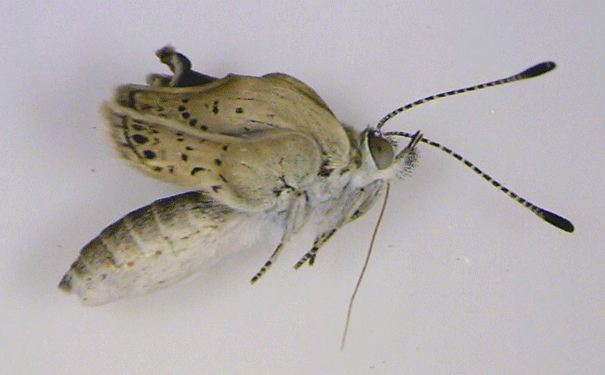
A mutilated pale grass blue butterfly found near Fukushima Dai-Ichi Nuclear Power Plant. Image: Chiyo Nohara/University of the Ryukyus
Forget your childhood radioactive superheroes, these insects have a lot more to worry about.
It’s hard to forget the devastation caused by the March, 2011 TÅhoku earthquake. The 9.0 magnitude tremor triggered a tsunami that sent over 14-metre waves of water crashing down on the reactors at the Fukushima Dai-ichi Nuclear Power Plant, Japan, causing the largest nuclear disaster since Chernobyl in 1986. While health officials raced to quickly stabilise the situation, it was unclear how much radiation had made it out of the plant — and how it could affect people, plants, and animals that came into contact with it.
Although preliminary studies have suggested that most of the 140,000 people in the surrounding areas of Fukushima wouldn’t suffer from any adverse health effects, a study published in Nature has linked the nuclear accident to the mutations of a particularly sensitive population — the pale grass blue butterfly (Zizeeria mama). These insects have suffered from a number of uncommon and potentially lethal physical abnormalities, including infertility, deformed wings, dented eyes, aberrant spot patterns, malformed antennas and legs and the inability to fight their way out of their cocoons. “We conclude that artificial radionuclides from the Fukushima Nuclear Power Plant caused physiological and genetic damage to this species,” the researchers reported in their paper.
The researchers, including Joji Otaki, a professor at the University of the Ryukyus in Japan and senior author of the paper, collected 144 adult butterflies two months after the nuclear disaster from 10 different locations across Japan, including the Fukushima area. They observed changes in the butterflies’ eyes, wing shapes and colour patterns. “It has been believed that insects are very resistant to radiation,” Otaki told the BBC. “In that sense, our results were unexpected.”
The team also bred the collected butterflies at the university’s labs in Okinawa, 1,750 kilometres from Fukushima. They noticed more severe abnormalities in successive generations that hadn’t been seen in the previous generation, such as forked antennas and asymmetrical wings.
Last September, six months after the radiation, the team collected more adults from seven of the 10 sites and found that the butterfly population included more than twice as many members with abnormalities as in May: 28.1 per cent versus 12.4 per cent. The researchers concluded that this higher rate of mutation likely came from butterfly larvae eating contaminated leaves and also from mutations of genetic material being passed onto subsequent generations by mutant parents.
“One very important implication of this study is that it demonstrates that harmful mutations can be passed from one generation to the next, and that these might actually accumulate and increase over time, leading to larger effects with each generation,” Timothy Mousseau, a professor of biology at the University of South Carolina, told LiveScience. “It is quite concerning to see accumulated effects occurring over relatively short time periods, less than a year, in Fukushima butterflies.”
It is still unclear whether these findings will have any implications for the human population — a study published in the Journal of the American Medical Association indicated that there were low levels of radiation in the people who had been living in the area before the meltdown. “Our findings suggest that the contaminants are causing ecological damage. I do not know its implication to humans,” Otaki told the Associated Press.






